Introduction
All nations are responsible for providing high-quality education (UNESCO, 2017). ICT has become essential in higher education, shaping teaching and learning methods (Bates, 2019). According to Mishra and Koehler (2006), digital technologies have revolutionized pedagogical approaches, demanding faculty members to acquire and possess proficient ICT competencies, impacting the quality of education provided to students (Altbach et al., 2009).
The debate around the use of ICT in education has seen consistent and expanding in recent times (Ramírez-Montoya, 2020). The COVID-19 pandemic has underscored the need to use new technical tools, technological advancements, and instructional methodologies backed by ICT (Mseleku, 2020). The opposition against distance learning has diminished in importance due to the urgent implementation of this instructional method in universities (König et al., 2020). The urgent situation led to several articles discussing the difficulties and advantages associated with online learning in the context of the pandemic (Adedoyin et al., 2020). Conversely, it generated individual anxiety (Dhawan, 2020). Cabero-Almenara et al. (2020) noted that ICT has significantly transformed literacy. Due to the pandemic, many educational institutions have shifted to online platforms (Bakator & Radosav, 2020). This transition required educators in higher education institutions (HEI) to enhance their digital literacy skills (Trubavina et al., 2021) and improve their digital literacy skills (Garzón Artacho et al., 2020). However, educators face new challenges in effectively utilizing and adapting to emerging technologies to meet evolving needs, demanding to acquire a more extensive and refined skill set compared to previous times (Redecker, 2017).
Educators must acquire proficiency using software and online platforms, create digital formats, and adapt their instructional speed accordingly (Feng et al., 2020). Academic research has explored potential strategies to address the significant challenge of digital transformation in education (Ochoa Fenández, 2020). Effective communication between educators and students has become more crucial in COVID-19, emphasizing the quality of communication between instructors and students, focusing on fostering effective two-way communication (Martin, 2020).
Faculty members, often hailed as the backbone of any educational institution, play a pivotal role in this transformation (Bates, 2019). The digital divide among faculty, characterized by varying degrees of ICT competencies, poses a significant challenge to equitable education delivery (Selwyn, 2011). This discrepancy raises important questions regarding higher education institutions’ role in facilitating ICT development (Eynon, 2013). It raises concern about how these contradictions influence students’ learning experiences (Selwyn, 2011). Traditional faculty, who were introduced to technology later in life, have a significant knowledge gap compared to modern faculty, who are more familiar with digital educational resources (Yelubay et al., 2020). This difference is evident in using teaching tools like electronic textbooks and Internet technologies (Nyikes, 2017). The absence of a digital culture leads to a lack of familiarity with digital technology, resulting in significant knowledge gaps within the school system (Ochoa Fenández, 2020). Therefore, the issue of equipping educators with the necessary skills to effectively use digital technology remains a significant concern (Falloon, 2020). Camacho (2014) highlights the need for HEIs to enhance faculty’s ICT competencies through strategies for infrastructure and training needs. However, faculty need to be more interested in developing research, management, and administration.
This paper examines ICT competencies among higher education faculty and proposes a model to enhance these skills. It argues that faculty proficiency in using ICT tools is crucial for the quality of education they provide. As the digital landscape evolves, educators must adapt and equip themselves with the necessary ICT competencies to remain practical and relevant (Eynon, 2013). This research aims to guide HEI in bridging the ICT competency gap among faculty members. It identifies strengths and areas for improvement, allowing institutions to tailor professional development programs. The findings may contribute to the broader discourse on the role of technology in education, offering insights into the relationship between faculty ICT competencies and student learning outcomes. The findings provide actionable insights for institutions, policymakers, and educators, enabling informed decisions about faculty development, training, and technology integration strategies.
A literature review is presented in the subsequent section. Next, the research methodology is introduced. The following section shows the results. Then, the final section presents a discussion that includes the study’s contributions, implications, and limitations.
Literature Review
In the 21st century, HEIs face challenges in integrating ICT due to its widespread use in daily routines (Albion et al., 2015). The significance of ICT skills and competencies, as well as the digitalization of education, is recognized through national and international policies (Bond et al., 2018). ICT skills involve understanding and effectively using digital processes and technologies, while competence involves the aptitude to perform tasks proficiently and effectively (Bartman et al., 2011). Digital competencies (DC) involve the proficient and discerning use of electronic media for professional, recreational, and communicative purposes and the aptitude to do a task with proficiency and effectiveness (Vitello et al., 2021). These competencies encompass attitudes, knowledge, skills, awareness, and values related to logical and critical thinking, advanced information management, and proficient communication abilities (Levano-Francia et al., 2019).
ICT enhances teaching, facilitates information transfer, increases student engagement, and serves as a communication medium, creating an inclusive and dynamic atmosphere (García-Valcárcel et al., 2014). Therefore, ICT integration is crucial for a successful educational system (Livingstone (2012). External barriers encompass a need for more technology-based infrastructure, time limitations, and insufficient technical or pedagogical support (Eickelmann & Vennemann, 2017). The financial resource is an obstacle for skills-based training programs, often leading to novice educators’ participation (Kreijns et al., 2013). Implementing these programs is crucial as they effectively mitigate the “digital divide” between educators and their students (Fernández-Cruz et al., 2016). To effectively integrate ICT, strategies and initiatives need a thorough understanding of the current conditions, including students’ and educators’ digital skills and aptitudes. Martin et al. (2011) suggest that ICT in the education system is often driven by trends rather than evidence-based decision-making.
The pandemic has led to a rise in online teaching and learning methods in higher education facilitated by digital technology (Bakator & Radosav, 2020). However, educators need support in adopting a comprehensive approach to digital learning, including blended learning, e-textbooks, and virtual classrooms (Bakator & Radosav, 2020). Technology has enhanced teaching and learning processes (Guillén-Gámez & Mayorga-Fernández, 2020), and educators’ attitudes are crucial in integrating technology into education (Caena & Redecker, 2019; Kotlyarova et al., 2019), and it is suggested that a shift towards a more comprehensive framework encompassing diverse knowledge. Assessments of ICT competencies in education face challenges, as they often focus on individual competencies and overlook the complexities of technology integration in diverse educational contexts (Anderson & Dron, 2011). Standardized assessment tools are needed to provide a holistic view of faculty ICT competencies. However, challenges exist, such as resistance from students unfamiliar with technology-rich environments, ensuring equitable access to technology, and addressing digital literacy issues among students (Bates, 2019).
HEIs have recognized the need for faculty development programs to enhance ICT competencies (Eynon, 2013). These programs encompass training, workshops, and support mechanisms to empower faculty members to use technology. The goal is to equip educators with the skills and knowledge necessary for effective technology integration. Faculty development initiatives vary widely in scope and approach. They may include workshops on specific software applications, online teaching and learning courses, and ongoing support through instructional designers and educational technologists (Bates, 2019).
Research questions
This study aimed to answer these questions:
- What is the ICT competency level of the HEI faculty?
- How will a training process on ITC improve faculty competencies in the HEI selected?
Materials and Methods
The study used a quantitative method to understand faculty ICT competencies. The study was conducted with professors from a Santo Domingo, Dominican Republic University’s marketing program. In order to have a more consistent study and results, the entire marketing faculty population of the university of study participated in the research; therefore, 12 faculty members, including eight men and four women, participated.
Participants were given informed consent, which guaranteed their participation would not have negative consequences and would not affect the evaluation of their performance at the university. Torres (2012) questionnaire was used to assess essential ICT competencies. It consisted of five parts: personal variables, interest-based adoption, evaluation of ICT management, educational application, and faculty attitudes. The questionnaire collected general information from participants, evaluated the adoption of technologies across specialization levels, deepened participants’ knowledge about technological-didactic equipment and instruments, assessed planning and execution processes for integrating ICT into teaching-learning processes, and evaluated faculty attitudes through fifty items. A pilot was conducted with 60 faculty members to correct any misunderstandings. The study followed the pretest-treatment-post-test design, as suggested by McMillan and Schumacher (2010). The questionnaire for pretest and post-test was the same but conducted at different times, and the analysis focused on the change from the pre-test to the post-test.
Procedures
Descriptive statistics were used in this study to summarize and organize large amounts of research observations, following what was stated by McMillan and Schumacher (2010) in educational research. The aim was to transform the data into indices that describe or characterize the data. The methodology involved several activities. First, a pretest was administered to participants to assess their level of ICT competencies. The results of the pretest were analyzed to identify areas of weakness. Second, an educational intervention was implemented to address the identified problems. This intervention consisted of a nine-week training program on teaching in virtual environments. The training included face-to-face and distance training, focusing on practical and conceptual aspects of virtual education. The training process was constantly evaluated using formative and summative assessments. Finally, a post-test was implemented to measure improvements in ICT competencies among participants.
Results
Table 1 exhibits demographics. The sample is composed of 12 professors, 58% are over 40 years of age, 75% of them with a master’s degree, 17% with a doctorate (two faculty), and one with a bachelor’s degree. Regarding gender, 58% were men and 42% were women, and based on contract type, 75% were adjuncts, 8% were part-time, and 17% were full-time. Also, 75% have been teaching for over five years, all have a computer at home, and 58% use it more than 5 times a week. It is important to note that all the faculty participating in the research have computers.
Table 1. Demographics

Note. EL: level of education; B: bachelor’s degree; M: master’s degree; D: Doctorate; TP: Contract type; FT: full-time; PT: part-time; AD: adjunct.
First Research Question
The first research question is: What is the ICT competency level of the HEI faculty? Table 2 exhibits results for MS Office, Internet, and email. Regarding word processors, 66% use it more than five times a week, and 58% when asked about spreadsheets. For the use of PowerPoint, 33% use it two to three times per week, and 100% indicated they use the Internet and email more than five times a week.
Table 2. Use of MS Office, the Internet, and e-mail

Table 3 shows essential competencies in ICT, specifically computer and operational systems. 66.67% know the essential elements of computers, 66.67% know the basic peripherals and 58.33% know how to install programs. Similarly, 83.33% know how to save and retrieve information on different devices, 50% know how to maintain their equipment, and 66.67% know how to use shared resources in a network.
Table 3. Essential competencies in information technology: computer and operational system
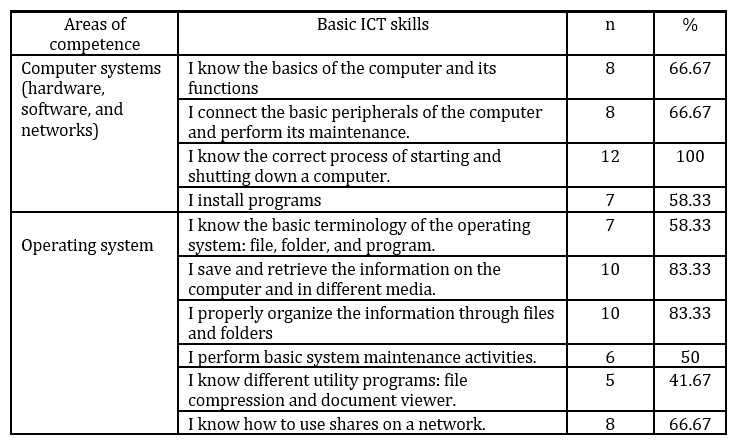
Table 4 shows that 66.67% use browsers in a basic way, and 83% use search engines to locate specific information. 58.33% were straightforward about the search objective, and 25% understood they had criteria to evaluate the reliability of the information on the Internet. Regarding interpersonal communication and collaborative work in networks, 91.67% can send, receive, and organize emails with electronic addresses and attach files to their messages. 66.67% responsibly use ICTs for personal communication and know the different uses of mobile phones. Also, 58.33% knew the rules of courtesy for adequate communication through the network.
Table 4. Essential competencies in information technologies: information search and interpersonal communication

Table 5 groups results about data and multimedia processing skills. 75% know the basic terminology about text editors, 83.33% can write, organize documents internally, copy, paste, work the margins of the documents, and the fonts that would be used, 75% know how to insert images and graphic elements within their documents, as well as use the keyboard properly. Similarly, 83.33% know how to use spelling corrections and synonyms to improve the documents that they make.
Table 5. Essential competencies in information technologies: text, image, and multimedia processing
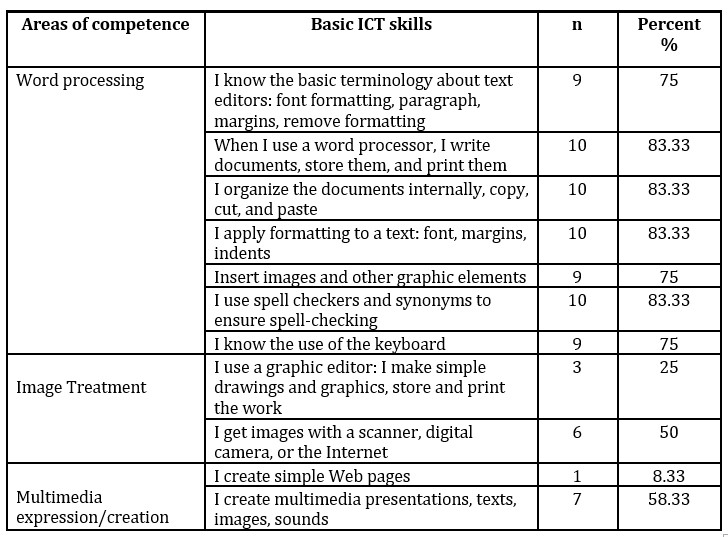
On the other hand, table 6 shows the results of statistical calculations and graphs. 75% said they know the basic terminology in the spreadsheets, 91.67% only make simple calculations in spreadsheets, and 58.33% can elaborate graphs from the collected data. Regarding the use of a database, only 8.33% can use a database for research, and 16.67% can enter new data into a database through a form.
Table 6. Essential competencies in Information Technologies: calculation and database
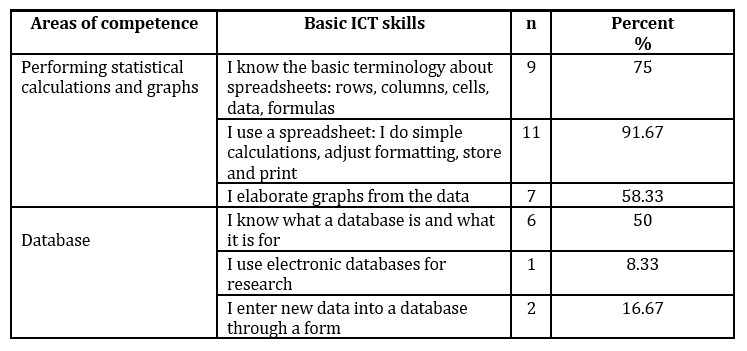
Regarding educational planning, table 7 shows that 66.67% have carried out their teaching work with ICT tools that allow the design, management, and control of the teaching process. Also, 50% keep planning documents that make it easier for them to manage new similar teaching activities, and 16.67% share planning documents with other faculty. Similarly, 50% deliver a simple and didactic version of the educational plan to administrators and students, 8.33% can determine the pedagogical model they use in their teaching practices, and 16.67% design a specific plan for applying ICTs in the curriculum and share them with their fellow faculty.
Table 7. Essential competencies in information technologies: Educational planning
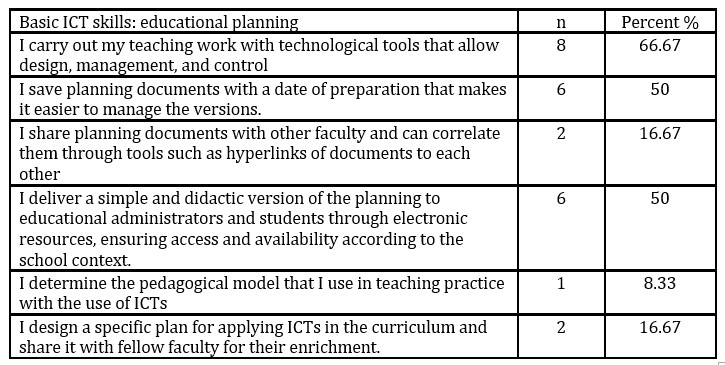
The process of teaching execution with the use of ICTs is presented in Table 8. 41.67% designed didactic materials, evaluations, activities, and tasks, 16.67% used technological resources of the institution, 66.67% used and applied word processors and presentations in their classes, and 41.67% systematize learning experiences. In this same vein, 41.67% use of ICTs strengthens learning processes, 33.33% use ICTs to promote different learning processes, 25% have records of the progress of each of their students using ICTs, and 16.67% indicated that they apply at least one of the methodological proposals of ICTs to increase collaborative work within their students.
Table 8. Information Technology Core Competencies: Implementation Process
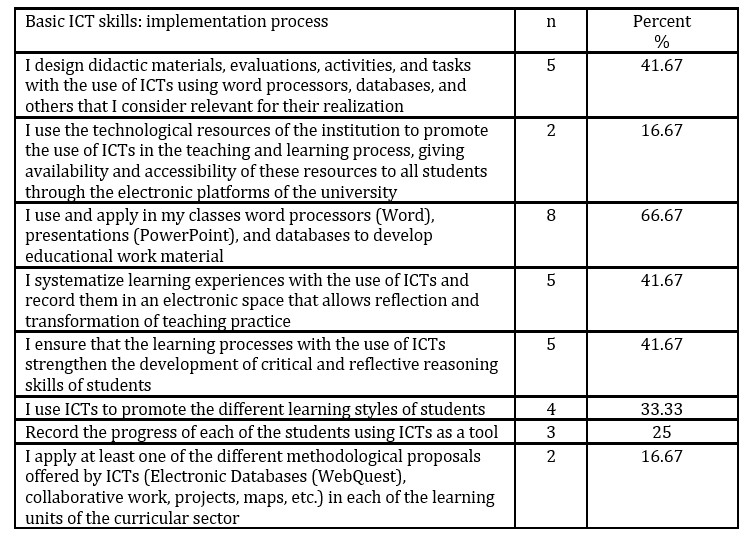
Second Research Question
How will a training process on ITC improve faculty competencies in the HEI selected? In Table 9, results show a significant increase in computer use in teaching activities, with a 16.67% increase in new data entering databases. The use of multimedia presentations and web pages also showed a favorable change, significantly increasing from 58.33 to 77.78. The use and administration of email messaging showed a favorable increase from 91.67% to 100% among faculty, with a similar increase in rules of courtesy for adequate communication. The objectives of searching for information on the network showed a favorable increase from 58.33% to 100%, with an increase from 25% to 55.56%.
Table 9. Computer skills in teaching activity
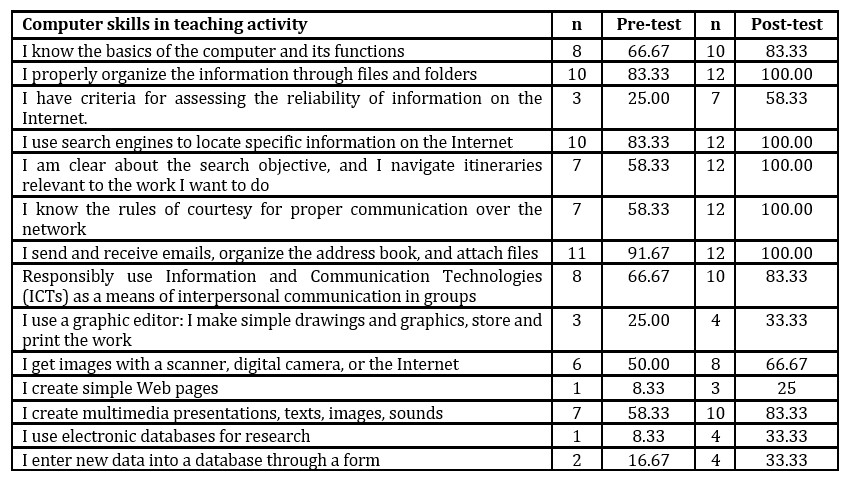
The study analyzed variables related to educational planning and execution, which directly affect knowledge creation between faculty and students. The results showed a positive increase in applying various ICT methodologies, student registration, and promotion of different learning styles. Systematization of learning experiences using ICTs and their registration in electronic spaces also showed a positive increase. The design of a specific plan for ICTs in the curriculum and sharing it with fellow faculty showed a favorable change from 16.67% to 33.33%. Overall, using ICTs in education significantly impacts knowledge creation and student learning (Table 10).
Table 10. Competence in educational planning and execution
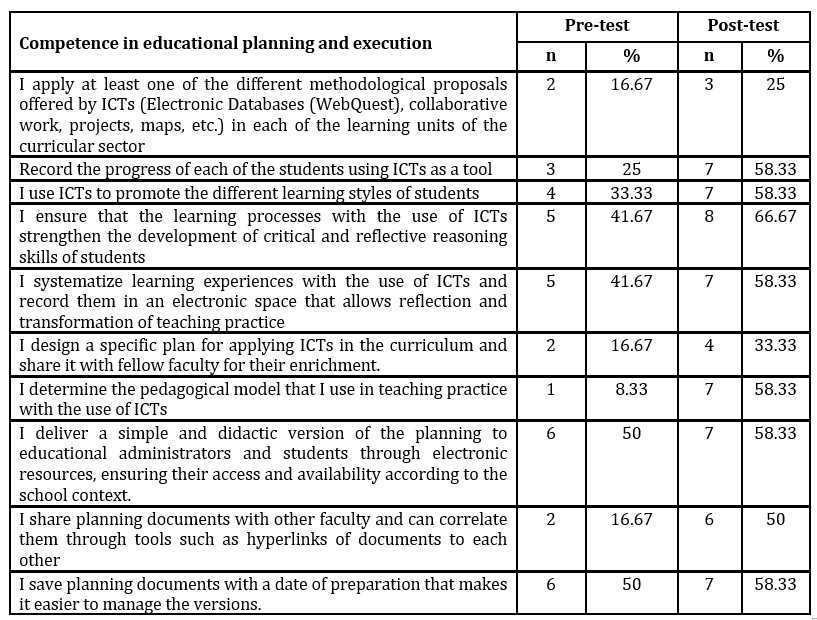
Discussion
The study also revealed that 75% of faculty do not naturally use technology in their teaching processes and are unfamiliar with virtual classroom facilities. Additionally, the pretest showed that only a small percentage of faculty used word processors, spreadsheets, and PowerPoint frequently. These findings contradict Kotlyarova et al. (2019) on the importance of acquiring and using ICT and the importance of digital literacy for educators in contemporary culture, as stated by Caena and Redecker (2019) and Käck et al. (2019).
The study found that most faculty use the Internet and email more than five times a week, 91.67%; however, only 66.67% know the essential elements of computers and basic peripherals, and 58.33% know how to install programs on their equipment. Despite 92% having received training in ICTs, faculty are not motivated to integrate ICTs into their academic activities. This lack of motivation affects their commitment to acquiring ICT skills, which can be detrimental to developing technological components within their current subjects. This contradicts Garzón Artacho et al.’s (2020) understanding that integrating ICT into education has prompted faculty to enhance their digital literacy skills.
The study suggests HEIs should adopt ICT-based education practices to ensure access to and critical use of information. Only 50% of faculty deliver simple, didactic plans to academic administrators and students, 8.33% can determine pedagogical models, and 16.67% design specific plans for ICTs in the curriculum falling short of UNESCO’s (2008) standards, suggesting combining ICT skills with pedagogy, curriculum, and school organization innovations. The low integration of ICT tools in education hinders innovation and knowledge creation for students and faculty. Pretest assessment identified 41.47% design teaching materials and 41.67% systematized learning experience. New roles for faculty should include designing student work, facilitating the learning process, and being a mentor (Redecker (2017). According to Tretinjak & Andelic (2016), multimedia education directly impacts the evolution and development of teaching-learning, impacting the contemporary perspective of higher education.
The study shows that 41.67% of faculties believe ICTs enhance learning processes, 33.33% use them for different learning processes, 25% have student progress records, and 16.67% increase collaborative work. However, low integration is due to inefficient support for virtual teaching due to a lack of institutional support, as stated by Eickelmann & Vennemann (2017).
The environment significantly influences university faculty’s ICT competencies, involving analysis of institutional variables (culture, human and financial resources, and technological platforms), integrating technology into teaching processes, developing management skills, and fostering relationships and communication for collaboration (Fernández-Cruz et al., 2016), and consensus decision-making enhances teaching effectiveness (Garzón Artacho et al., 2020).
A training program was conducted to assess the efficiency of a virtual education model. Participants were trained in virtual management using Moodle, an online platform. The program lasted 9 weeks, with participants investing 72 hours to complete assignments. Falloon (2020) suggests that developing computer skills in faculty training institutions is crucial for optimizing the teaching-learning-evaluation process. Integrating resources like WebQuest into didactic activities based on constructivist learning elements is essential.
The study assessed the impact of a virtual learning environment on faculty management and educational processes in marketing careers at a university. The findings indicated that the proposed model was effective despite some limitations and changes during the training process. Initially, there was a 25% decrease in participants, suggesting that those who did not recognize the importance of training did not attend. Despite using technological tools for constant communication, performance variability necessitated the creation of additional face-to-face workshops.
The study found a significant increase in computer use in teaching activities, including skills in entering new data into databases, using electronic databases for research, preparing multimedia presentations, and elaborating web pages. The responsible use of ICTs also improved, aligning with Ochoa Fenández’s (2020) recommendation for strategies to address digital transformation in education. Competencies related to network information search showed a favorable change of 71.4%, from 58.33% to 100%, and a 20% increase in using search engines for specific information. The reliability of information obtained by the network was also improved by 122%, from 25% to 55.56%. The results of the pre-test and post-test evaluation of faculty management training in virtual learning environments align with Trubavina et al.’s (2021) evaluation model for training programs.
Conclusions
According to the research, integrating ICTs in higher education faces challenges and obstacles, such as faculty members lacking ICT skills. However, implementing a training process to develop teaching competencies in ICTs resulted in increased technology integration in teaching at the university studied. The training improved faculty instruction planning and applied knowledge, techniques, and competencies in the subjects offered. While the research focused on the marketing career at the university, the model can also be applied to other careers.
When initiating the intervention process, 75% of faculty members did not use ICTs in their teaching processes. However, at the end of the training process, 33% of faculty members had applied at least one of the different methodologies offered by ICTs. The evaluation of whether they used ICTs to promote further learning styles within students increased by 67%. Faculty members expressed their ignorance regarding the use and facilities allowed by the virtual classroom, leading to fears about starting the training process. However, the training increased skills related to network search, search engine usage, and critical and reflective reasoning skills.
Results also showed favorable changes in the design of specific plans for applying ICTs in the curriculum, with a 567% increase in determining the pedagogical model used in teaching practices using ICTs. Socialization within the implemented model was also positively impactful, with a 166.6% increase in sharing planning documents with other faculty members. The results demonstrated the model’s effectiveness in developing teaching competencies in ICTs, improving the teaching process of faculty members, and allowing the institution to offer nine potential subjects entirely online or blended modality.
Managerial Implications
The research highlights the significance of allocating resources toward training initiatives aimed at improving ICT competencies of faculty members. It is recommended that academic institutions implement comprehensive training programs designed to enhance teaching abilities in ICT. These programs must include not just fundamental ICT skills but also explore sophisticated pedagogical strategies and proficiencies enabled by technology. Also, managers and administrators need to tailor training methodologies to accommodate the distinct needs and demands of various academic disciplines. This involves the creation of discipline-specific modules that are by the curriculum and teaching methodologies commonly used in each field of study. Evaluating and monitoring progress is of utmost importance for institutions to measure the efficacy of their training activities. It is essential to establish a systematic process for assessing the advancement of faculty members in integrating ICT into their teaching practices.
The research provides evidence that the effective integration of ICT may facilitate educational institutions in expanding their offerings to include a broader selection of disciplines via online or mixed formats. It is advisable for managers to actively investigate new avenues for increasing the choice of online courses available, as this can enhance student accessibility and attract a more diverse cohort of learners.
Limitations
The research primarily focused on faculty marketing inside a specific institution. Therefore, the results of this study may not be readily applicable to other scholarly fields or educational institutions with unique settings and requirements. The model’s efficacy and training procedure may exhibit variability across diverse academic environments. The study indicates that the model has potential applicability to several professional fields. However, the degree to which it may be effectively extrapolated to include a wide range of academic subjects still needs to be investigated. The dynamics of different areas of study, faculty competence, and curricular systems may influence the application of results.
The research largely evaluated the immediate effects of the training procedure. More attention should have been given to examining longer-term impacts, namely the sustainability of integrating information and communication technology (ICT) and its lasting impact on teaching methods. To have a complete comprehension of the enduring effects, it would be imperative to conduct longitudinal research.
The research may possess several limitations about the size and selection of its sample. The proper representation of the larger population of faculty members inside the school or across multiple institutions is a critical factor that has to be considered. Increasing the size and diversity of the sample would contribute to the overall strength and reliability of the results.
The study lacks a comprehensive examination of external variables that could impact the integration of information and communication technology (ICT), such as alterations in technological infrastructure, availability of resources, or variations in policies. The influence of external factors on the adoption of information and communication technology (ICT) may have a substantial impact on its overall success.
References
- Adedoyin, OB.and E. (2023) ‚Covid-19 pandemic and online learning: the challenges and opportunities‘, Interactive Learning Environments, 31:2, 863-875, DOI: 10.1080/10494820.2020.1813180
- Albion, P. R., Tondeur, J., Forkosh-Baruch, A., Peeraer, J. (2015), “Teachers’ professional development for ICT integration: Towards a reciprocal relationship between research and practice”, Education and Information Technologies, 20(4), 655-673.
- Albion, PR., Tondeur, J., Forkosh-Baruch, A. and Peeraer, J. (2015), ‘Teachers’ professional development for ICT integration: Towards a reciprocal relationship between research and practice’. Education and Information Technologies, 20(4), 655-673.
- Altbach, PG., Reisberg, L. and Rumbley, LE. (2009) ‘Trends in Global Higher Education: Tracking an Academic Revolution’, UNESCO 2009 World Conference on Higher Education, Paris, 5-8 July 2009.
- Anderson, T. and Dron, J. (2011) ‘Three generations of distance education pedagogy’, The International Review of Research in Open and Distributed Learning, 12(3), 80–97. https://doi.org/10.19173/irrodl.v12i3.890
- Baartman, LKJ. and de Bruijn, E. (2011) ‘Integrating knowledge, skills and attitudes: Conceptualising learning process towards vocational competence’, Educational Research Review, 6(2), 125-134.
- Bakator, M. and Radosav, D. (2020) ‘Analyzing the digital education revolution. In: International Conference on Information Technology and Development of Education-ITRO, October 2020. Zrenjanin, Republic of Serbia.
- Bates, AW. (2019) Teaching in a Digital Age – Second Edition. Vancouver, B.C.: Tony Bates Associates Ltd.
- Bond, M., Marín, VI., Dolch, C., Bedenlier, S. and Zawacki-Richter, O. (2018) ‘Digital transformation in German higher education: student and teacher perceptions and usage of digital media’, International Journal of Educational Technology in Higher Education, 15(1), 1-20.
- Cabero-Almenara, J., Gutierrez-Castillo, JJ., Palacios-Rodriguez, A., and Barroso-Osuna, J. (2020) ‘Development of the teacher digital competence validation of DigCompEdu check-in questionnaire in the university context of Andalusia (Spain)’, Sustainability, 12(15), 6094. https://doi.org/10.3390/su12156094
- Caena, F. and Redecker, C. (2019) ‘Aligning teacher competence frameworks to 21st century challenges: The case for the European Digital Competence Framework for Educators (Digcompedu)’, European Journal of Education, 54(3), 356–369. https://doi.org/10.1111/ejed.12345
- Camacho, LJ. (2014) ‘Nuevos roles de los docentes en la educación superior: Hacía un nuevo perfil y modelo de competencias con integración de las TIC’, Ciencia y Sociedad, 39(4), 601-640.
- Dhawan, S. (2020) ‘Online Learning: A Panacea in the Time of COVID-19 Crisis’, Journal of Educational Technology Systems, 49(1), 5-22
- Eickelmann, B. and Vennemann, M. (2017) ‘Teachers‘attitudes and beliefs regarding ICT in teaching and learning in European countries’, European Educational Research Journal, 16(6), 733-761.
- Eynon, R.(2013) ‘The rise of Big Data: what does it mean for education, technology, and media research?’, Learning, Media and Technology, 38(3), 237-240. https://doi.org/1080/17439884.2013.771783
- Falloon, G. (2020) ‘From digital literacy to digital competence: The teacher digital competency (TDC) framework’, Educational Technology Research and Development, 68(5), 2449–2472. https://doi.org/10.1007/s11423-020-09767-4
- Feng, XH., Hu, XC., Fan, K. and Yu, T. (2020), ‘A brief discussion about the impact of coronavirus disease 2019 on teaching in colleges and universities of China’, Proceedings of the 2020 International Conference on E-Commerce and Internet Technology (ECIT), 22-24 April 2020, Zhangjiajie, China. https://doi.org/10.1109/ECIT50008.2020.00044
- Fernández-Cruz, FJ. And Fernández-Díaz, MJ. (2016) ‘Generation z’s teachers and their digital skills’, Comunicar, 24 (46), 97-105.
- García-Valcárcel, A., Basilotta, V. and López García, C. (2014) ‘ICT in collaborative learning in the classrooms of primary and secondary education’, Comunicar, 21( 42), 65-74.
- Garzon Artacho, E., Martinez, TS., Ortega Martin, JL., Marin Marin, JA. and & Gomez Garcia, G. (2020) ‘Teacher training in lifelong learning—The importance of digital competence in the encouragement of teaching innovation’, Sustainability, 12(7), 2852. https://doi.org/10.3390/su12072852
- Guillen-Gamez, FD. And Mayorga-Fernandez, MJ. (2020) ‘Quantitative-comparative research on digital competence in students, graduates and professors of faculty education: An analysis with ANOVA’, Education and Information Technologies, 25(5), 4157–4174. https://doi.org/10.1007/s10639-020-10160-0
- König, J., Jäger-Biela DJ. and Glutsch, N. (2020), ‘Adapting to online teaching during COVID19 school closure: teacher education and teacher competence effects among early career teachers in Germany’, European Journal of Teacher Education, Vol. 43, No. 4, pp. 608-622.
- Kotlyarova, IO., Volchenkova, KN., Semenova, YV., Chuvashova, AD. and Lyashenko, MV. (2019), ‘Development of Digital Competence of Technical Specialists in the Electronic Information and Education Environment. Proceedings of the 2019 International Conference Quality Management, Transport and Information Security, Information Technologies (IT&QM&IS), Sochi, Russia, 2019, 617-621, https://doi.org/10.1109/ITQMIS.2019.8928400
- Kreijns, K., Vermeulen, M., Kirschner, PA., van Buuren, H. and van Acker, F. (2013) ‘Adopting the Integrative Model of Behaviour Prediction to explain teachers’ willingness to use ICT: A perspective for research on teachers’ ICT usage in pedagogical practices’, Technology, Pedagogy and Education, 22(1), 55-71
- Levano-Francia, L., Sanchez Diaz, S., Guillén-Aparicio, P., Tello-Cabello, S., Herrera-Paico, N. and Collantes-Inga, Z. (2019) ‘Digital Competences and Education’, Journal of Educational Psychology – Propósitos y Representaciones, 7(2), 569-588.
- Livingstone, S. (2012) ‘Critical reflections on the benefits of ICT in education’, Oxford Review of Education, 38(1), 9-24.
- Martin, A. (2020) ‘COVID notes from the field: Transitioning to digital learning’, Georgia Educational Researcher, 17(2), 1–14. https://doi.org/10.20429/ger.2020.170207
- Martin, S., Diaz, G., Sancristobal, E., Gil, R., Castro, M. and Peire, J. (2011) ‘New technology trends in education: Seven years of forecasts and convergence’, Computers& Education, 57(3), 1893-1906.
- McMillan, JH. And Schumacher, S. (2010) Research in Education: Evidence-Based Inquiry, Pearson: New Jersey.
- Mishra, L., Gupta, T. and Shree, A. (2020) ‘Online Teaching-Learning in Higher Education during Lockdown Period of COVID-19 Pandemic’, The International Journal of Educational Research Open, 1, 1-8.
- Mseleku, Z. (2020) ‘A literature Review of E-Learning and E-Teaching in the Era of Covid-19 Pandemic’, International Journal of Innovative Science and Research Technology, 5(10), 588-597.
- Nyikes, Z. (2017) ‘Creation proposal for the digital competency framework of the Middle-East European region’, Key Engineering Materials, 755, 106–111. https://doi.org/10.4028/www.scientific.net/KEM.755.106
- Ochoa Fenández, CJO. (2020), ‘Special Session—XR Education 21th. Are We Ready for XR Disruptive Ecosystems in Education? Proceedings of the 2020 6th International Conference of the Immersive Learning Research Network (iLRN), San Luis Obispo, CA, USA, 424-426. https://doiorg/10.23919/iLRN47897.2020.9155215
- Ramirez-Montoya, MS. (2020) ‘Challenges for Open Education with Educational Innovation: A Systematic Literature Review’, Sustainability, Vol. 12, No. 17, pp. 1-16.
- Redecker, C. (2017) ‘European framework for the digital competence of educators: DigCompEdu. En: Print. https:// doi. org/ 10. 2760/ 159770. Online, JRC107466 EUR 28775. Publications Office of the European Union, Luxembourg, ISBN 978–92–79–73718–3, p 978–92–79–73494–6 (pdf). https://doi.org/10.2760/178382
- Selwyn, N. (2011) Education and Ttechnology: Keys issues and debates, Continuum International Publishing Group: New York, NY
- Torres, L. (2012) ‘Evaluación de las competencias básicas en TIC’s de los docentes de una universidad pública mexicana. Disertación Aplicada Presentada al Abraham S. Fischler School of Education, Miami, FL.
- Tretinjak, MF. and Anđelić, V. (2016) ‘Digital competences for teachers: Classroom practice,.Proceedings of the 2016 39th International Convention on Information and Communication Technology, Electronics and Microelectronics (MIPRO). IEEE Publications, 807–811.
- Trubavina, I., Dotsenko, S., Naboka, O., Chaikovskyi, M., and Meshko, H. (2021) ‘Developing digital competence of teachers of Humanitarian disciplines in the conditions of COVID-19 quarantine measures, Journal of Physics: Conference Series, 1840(1), 012052. https://doi.org/10.1088/1742-6596/1840/1/012052
- UNESCO (2017) Education for Sustainable Development Goals. Learning Objectives. The United Nations Educational, Scientific and Cultural Organization, UNESCO Publishing, Paris
- UNESCO (2008) ICT Competency standards for teachers. The United Nations Educational, Scientific and Cultural Organization, UNESCO Publishing, Paris
- Vitello, S., Greatorex, J. and Shaw, S. (2021) “What is competence? A shared interpretation of competence to support teaching, learning and Assessment”. [Online], [Retrieved June 2023] https://www.cambridgeassessment.org.uk/Images/645254-what-is-competence-a-shared-interpretation-of-competence-to-support-teaching-learning-and-assessment.pdf
- Yelubay, Y., Seri, L., Dzhussubaliyeva, D., and Abdigapbarova, U. (2020) ‘Developing future teachers’ digital culture: Challenges and perspectives, IEEE European Technology and Engineering Management Summit (E-TEMS). https://doi.org/10.1109/E-TEMS46250.2020.9111827












